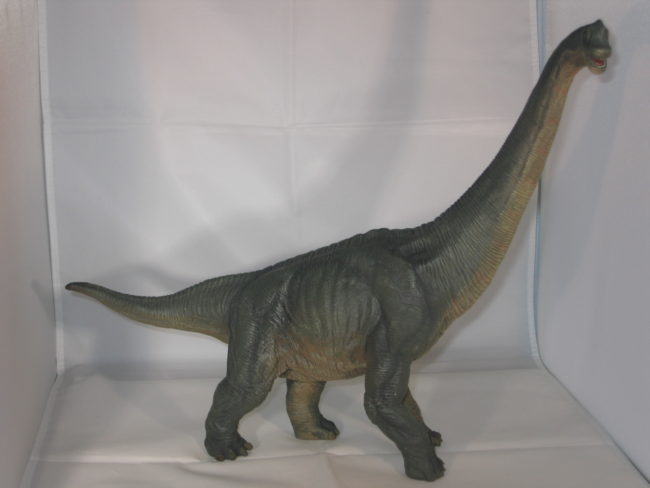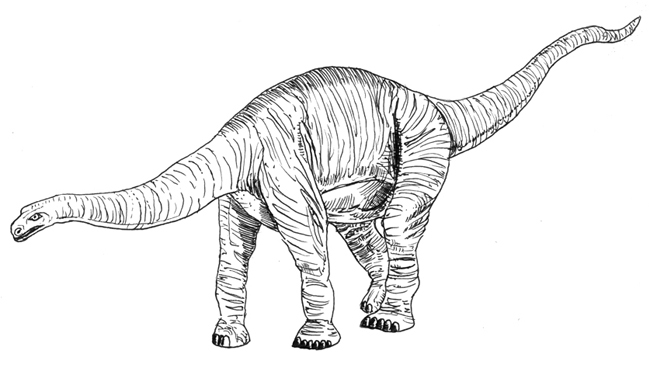Australian Museum Provides sneak Preview of new Dinosaur Exhibit
Preparations for the new permanent dinosaur exhibit at the Australian Museum in Sydney, New South Wales, are well advanced and the star exhibit, a life-sized model skeleton of a huge dinosaur has just been installed in the new exhibition hall.
Dinosaur Models
The model of the fossilised remains of a Cretaceous sauropod named Jobaria tiguidensis stands over 10 metres tall and its 22 metres just about fits into the newly erected exhibition hall of the museum. At the moment the model is still covered in protective wrapping and the scaffolding surrounding it indicates that the project team have one or two finishing touches to add, but when the new hall opens in March this exhibit will make an impressive centrepiece.
An Illustration of a Typical Sauropod
Picture credit: Everything Dinosaur
Producing Large Model Dinosaurs
The plastic model was cast from the real fossilised bones of this dinosaur, by a Chicago based organisation called Project Exploration which specialises in providing educational exhibits and materials. Light weight plaster casts have replaced the real fossil bones erected in museums, as being lighter they do not need the ugly looking steel girders to support them and to permit palaeontologists to depict animals in more life-like poses.
Besides, the fossils themselves are very valuable and are more likely to preserved in the storage rooms away from public display.
Purchasing casts like this for museums is very common, although it is quite unusual to have such a large model kit to be put together by the museum staff. Casts cost hundreds of thousands of dollars, whereas to purchase the actual fossilised bones would cost millions of dollars – a sum that even the Australian museum with its AUD $41 million budget would find hard to justify.
The bones of this long-necked dinosaur, a relative of Brachiosaurus as classified by Paul Sereno who placed Jobaria in the Macronaria clade of sauropods, lived in the Niger Republic area about 135 million years ago. Sauropods that belong to the Macronaria clade are distinguished from other long-necked dinosaurs as they have large nostrils high on their skulls. These may have been covered in fleshy, folds of skin to provide an enhanced sense of smell or to act as call resonating chambers.
For models of sauropods and other dinosaurs: Dinosaur and Prehistoric Animal Models.
Quite a lot is known about this giant plant-eater as an almost complete skeleton of Jobaria was unearthed by a team of palaeontologist led by Paul Sereno about ten years ago. To find a complete skeleton is exceptionally rare, even the huge bones of these dinosaurs are rarely found together. It was from this skeleton that the model bones were cast.
Jobaria and Other Sauropods
Jobaria lived in a lush, swampy area in what is now the Sahara desert. The name Jobaria comes from local Tuareg mythology – Jobar in the local dialect refers to a mysterious animal. Jobaria is one of the best understood genera of sauropods as fossil bones from adults and juveniles have been found. For a Cretaceous sauropod it was quite primitive with a disproportionately short neck compared to the length of its body and more primitive, chisel like teeth.
A Replica of a Sauropod Dinosaur (Brachiosaurus)

Dinosaur model gets reviewed. A replica of a brachiosaurid sauropod dinosaur. Picture credit: Everything Dinosaur.
Picture credit: Everything Dinosaur
The Jobaria model arrived in ten large crates and the museum team then set to putting the display together. It is not known how long the process took to erect the huge beast but the work was certainly worth it as this exhibit will form the main attraction on an new exhibition based on evolution when the new hall opens in March 2008.







Leave A Comment